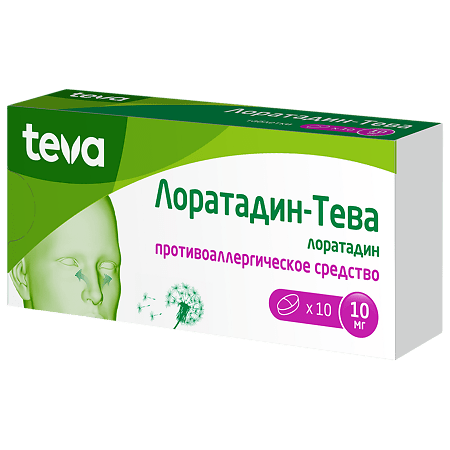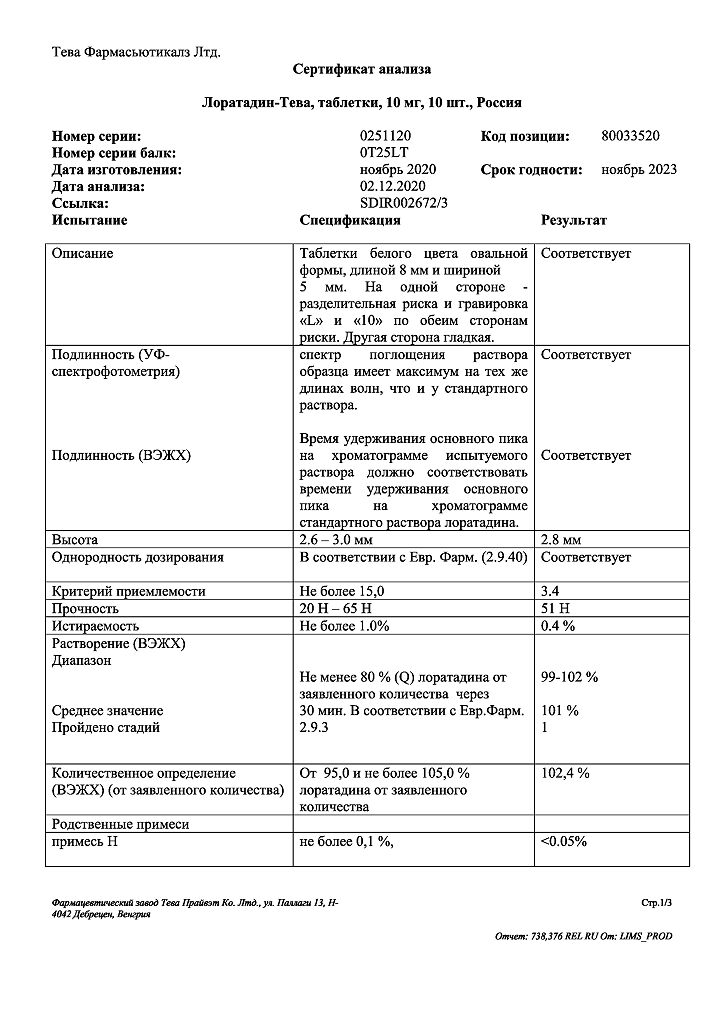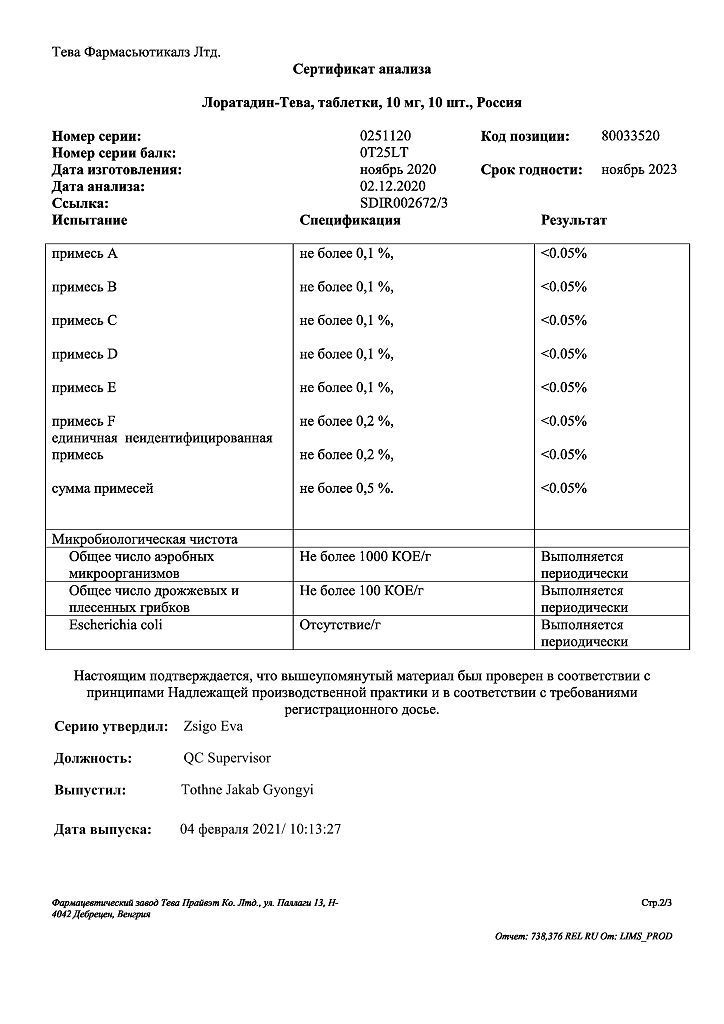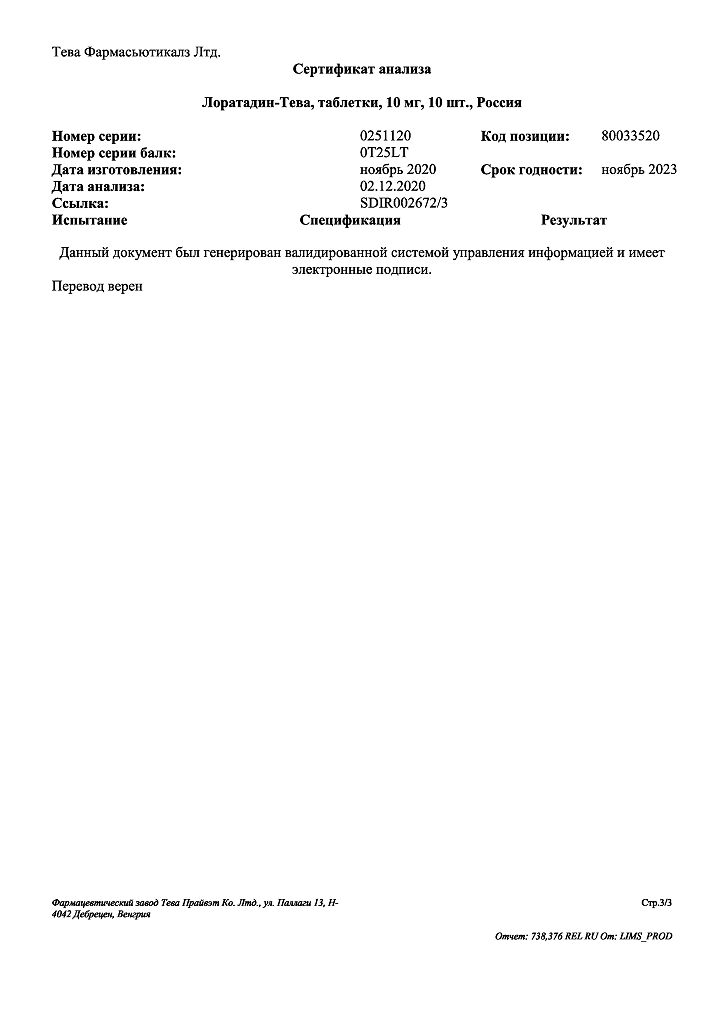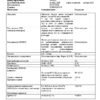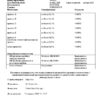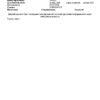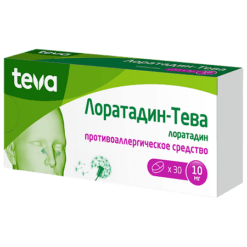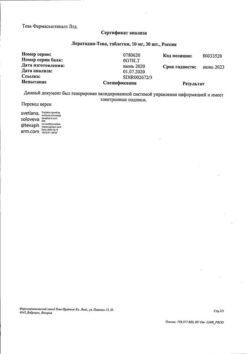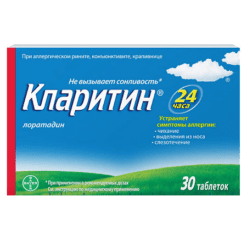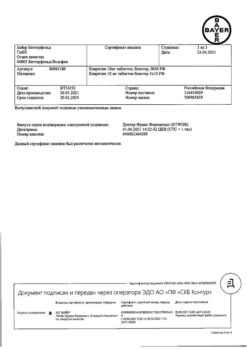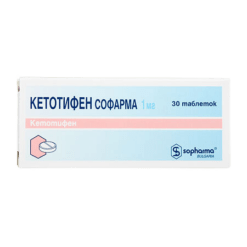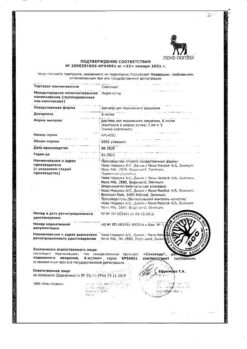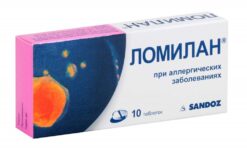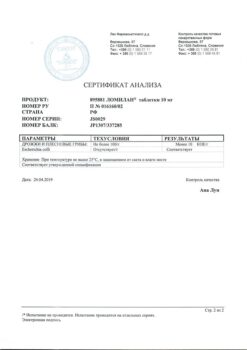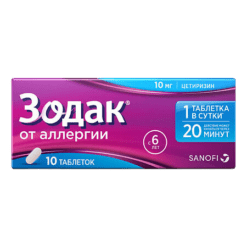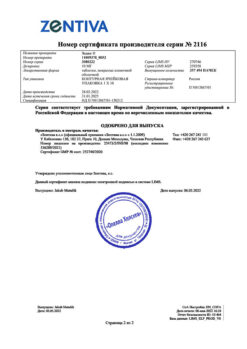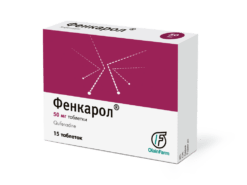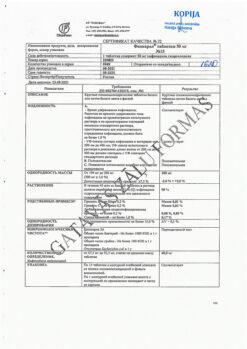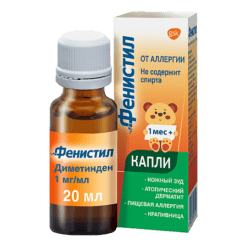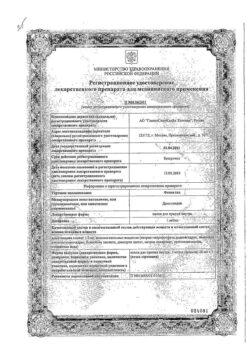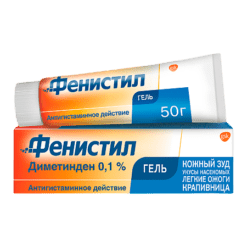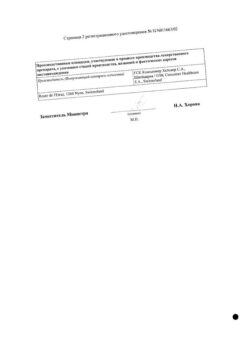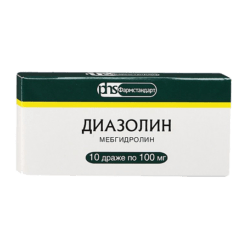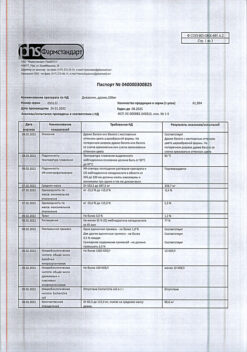No products in the cart.
Description
Pharmacotherapeutic group: anti-allergic agent – H1-histamine receptor blocker.
ATX code: R06AX13
Pharmacological properties
Pharmacodynamics
Loratadine, the active substance of the drug Loratadine-Teva, is a tricyclic compound with pronounced antihistamine action and is a selective blocker of peripheral H1-histamine receptors. It has a rapid and prolonged antiallergic effect. The onset of action is within 30 minutes after oral administration of the drug Loratadine-Teva. The antihistamine effect reaches its maximum after 8-12 hours from the beginning of action and lasts for more than 24 hours.
Loratadine does not penetrate through the blood-brain barrier and has no effect on the central nervous system. It has no clinically significant anticholinergic or sedative effect, i.e. it does not cause drowsiness and does not affect the speed of psychomotor reactions when used in the recommended doses. Administration of the drug Loratadine-Teva does not lead to prolongation of the QT interval on ECG.
Long-term treatment did not observe clinically significant changes in parameters of vital functions, physical examination data, results of laboratory tests or electrocardiography.
Loratadine has no significant selectivity toward H2-histamine receptors. It does not inhibit norepinephrine reuptake and has virtually no effect on cardiovascular system or rhythm driver function.
Pharmacokinetics
Loratadine is rapidly and well absorbed in the gastrointestinal tract. The time to reach maximum concentration (Tmax) of loratadine in blood plasma is 1-1.5 hours and its active metabolite desloratadine is 1.5-3.7 hours. Eating increases the time to reach the maximum concentration (Tmax) of loratadine and desloratadine by approximately 1 hour, but has no effect on the effectiveness of the drug. The maximum concentration (Cmax) of loratadine and desloratadine is independent of food intake. In patients with chronic renal disease, the maximum concentration (Cmax) and area under the curve “concentration – time” (AUC) of loratadine and its active metabolite are increased compared to patients with normal renal function. The elimination half-life of loratadine and its active metabolite does not differ from that of healthy patients. In patients with alcoholic liver damage Cmax and AUC of loratadine and its active metabolite are doubled compared to these parameters in patients with normal liver function. Loratadine has a high degree (97-99%) and its active metabolite has a moderate degree (73-76%) of binding to plasma proteins.
Loratadine is metabolized to desloratadine via the cytochrome P450 3A4 system and, to a lesser extent, the cytochrome P450 2D6 system. It is excreted through the kidneys (approximately 40% of the oral dose) and the intestines (approximately 42% of the oral dose) for more than 10 days, mainly as conjugated metabolites. About 27% of the ingested dose is excreted through the kidneys within 24 hours after drug intake. Less than 1% of the active substance is excreted unchanged through the kidneys within 24 hours after drug intake.
The bioavailability of loratadine and its active metabolite is dose-dependent.
The pharmacokinetic profiles of loratadine and its active metabolite in adult and elderly healthy volunteers were comparable.
The elimination half-life of loratadine ranged from 3 to 20 hours (mean 8.4 hours) and that of desloratadine from 8.8 to 92 hours (mean 28 hours); in older patients, from 6.7 to 37 hours (mean 18.2 hours) and 11 to 39 hours (mean 17.5 hours), respectively. The half-life increases with alcoholic liver damage (depending on the severity of the disease) and does not change in the presence of chronic renal failure.
Hemodialysis in patients with chronic renal failure has no effect on the pharmacokinetics of loratadine and its active metabolite.
Indications
Indications
• seasonal (hay fever) and year-round allergic rhinitis, allergic conjunctivitis – elimination of symptoms associated with these diseases: sneezing, itching of the nasal mucosa, rhinorrhea, burning sensation and itching in the eyes, lacrimation;
• chronic idiopathic urticaria.
Pharmacological effect
Pharmacological effect
Pharmacotherapeutic group: antiallergic agent – H1-histamine receptor blocker.
ATX code: R06AX13
Pharmacological properties
Pharmacodynamics
Loratadine, the active substance of the drug Loratadine-Teva, is a tricyclic compound with a pronounced antihistamine effect and is a selective blocker of peripheral H1-histamine receptors. Has a quick and long-lasting antiallergic effect. The onset of action is within 30 minutes after taking the drug Loratadine-Teva orally. The antihistamine effect reaches its maximum after 8-12 hours from the onset of action and lasts more than 24 hours.
Loratadine does not penetrate the blood-brain barrier and has no effect on the central nervous system. Does not have a clinically significant anticholinergic or sedative effect, i.e. does not cause drowsiness and does not affect the speed of psychomotor reactions when used in recommended doses. Taking the drug Loratadine-Teva does not lead to prolongation of the QT interval on the ECG.
During long-term treatment, no clinically significant changes in vital signs, physical examination findings, laboratory results, or electrocardiography were observed.
Loratadine does not have significant selectivity for histamine H2 receptors. Does not inhibit norepinephrine reuptake and has virtually no effect on the cardiovascular system or pacemaker function.
Pharmacokinetics
Loratadine is quickly and well absorbed from the gastrointestinal tract. The time to reach the maximum concentration (Tmax) of loratadine in the blood plasma is 1-1.5 hours, and its active metabolite desloratadine is 1.5-3.7 hours. Eating increases the time to reach maximum concentration (Tmax) of loratadine and desloratadine by approximately 1 hour, but does not affect the effectiveness of the drug. The maximum concentration (Cmax) of loratadine and desloratadine is independent of food intake. In patients with chronic kidney disease, the maximum concentration (Cmax) and area under the concentration-time curve (AUC) of loratadine and its active metabolite are increased compared to patients with normal renal function. The half-life of loratadine and its active metabolite does not differ from those in healthy patients. In patients with alcoholic liver damage, the Cmax and AUC of loratadine and its active metabolite are doubled compared to these values in patients with normal liver function. Loratadine has a high degree (97-99%), and its active metabolite has a moderate degree (73-76%) of binding to plasma proteins.
Loratadine is metabolized to desloratadine via the cytochrome P450 3A4 system and, to a lesser extent, the cytochrome P450 2D6 system. Excreted through the kidneys (approximately 40% of the oral dose) and intestines (approximately 42% of the oral dose) for more than 10 days, mainly in the form of conjugated metabolites. Approximately 27% of an oral dose is excreted through the kidneys within 24 hours after taking the drug. Less than 1% of the active substance is excreted unchanged through the kidneys within 24 hours after taking the drug.
The bioavailability of loratadine and its active metabolite is dose-dependent.
The pharmacokinetic profiles of loratadine and its active metabolite were comparable in adults and elderly healthy volunteers.
The half-life of loratadine ranges from 3 to 20 hours (mean 8.4 hours) and that of desloratadine ranges from 8.8 to 92 hours (mean 28 hours); in elderly patients, respectively, from 6.7 to 37 hours (average 18.2 hours) and from 11 to 39 hours (average 17.5 hours). The half-life increases with alcoholic liver damage (depending on the severity of the disease) and does not change in the presence of chronic renal failure.
Hemodialysis in patients with chronic renal failure does not affect the pharmacokinetics of loratadine and its active metabolite.
Special instructions
Special instructions
Loratadine should be discontinued 48 hours before skin testing, as antihistamines may interfere with diagnostic test results.
Read the instructions carefully before you start using the drug. Save the instructions, you may need them again. If you have any questions, consult your doctor. The medicine you are using is intended for you personally and should not be given to others as it may cause harm to them even if they have the same symptoms as you.
Impact on the ability to drive vehicles and machinery
No negative effect of the drug Loratadin-Teva on the ability to drive a car or perform other activities requiring increased concentration has been identified.
However, in very rare cases, some patients experience drowsiness while taking Loratadine-Teva, which may affect their ability to drive and operate machines.
Active ingredient
Active ingredient
Loratadine
Composition
Composition
1 tablet contains:
Active ingredient: loratadine 10.0 mg.
Excipients: lactose monohydrate 62.5 mg, corn starch 2.0 mg, pregelatinized starch 25.0 mg, magnesium stearate 0.5 mg.
Pregnancy
Pregnancy
There is insufficient clinical data on the use of loratadine in pregnant women. Use is possible only if the expected benefit to the mother outweighs the potential risk to the fetus.
Loratadine is excreted in breast milk. If it is necessary to use loratadine during lactation, breastfeeding should be discontinued.
Contraindications
Contraindications
Hypersensitivity to loratadine and other components of the drug; lactose intolerance, lactase deficiency, glucose-galactose malabsorption; breastfeeding period; children under 3 years of age and weighing less than 30 kg.
With caution
Severe liver dysfunction.
Pregnancy (see section “Use during pregnancy and breastfeeding”).
Side Effects
Side Effects
In clinical studies involving children aged 2 to 12 years, headache (2.7%), nervousness (2.3%), and fatigue (1%) were observed more frequently than in the placebo group (dummies).
In clinical trials in adults, adverse events observed more frequently than with placebo occurred in 2% of patients receiving loratadine. In adults, headache (0.6%), drowsiness (1.2%), increased appetite (0.5%) and insomnia (0.1%) were reported more often when using loratadine than in the placebo group. In addition, there have been very rare post-marketing reports (<1/10,000) of dizziness, fatigue, dry mouth, gastrointestinal disturbances (nausea, gastritis), allergic reactions such as rash, anaphylaxis including angioedema, alopecia, liver dysfunction, palpitations, tachycardia, seizures and weight gain bodies.
If any of the side effects indicated in the instructions get worse, or you notice any other side effects not listed in the instructions, tell your doctor.
Interaction
Interaction
Loratadine does not potentiate the effects of alcohol.
Eating does not affect the effectiveness of loratadine.
Erythromycin and ketoconazole (inhibitors of the CYP3A4 isoenzyme), cimetidine (inhibitor of the CYP3A4 and CYP2D6 isoenzymes) increase the Cmax of loratadine and its active metabolite in the blood. There are no clinically significant changes.
Overdose
Overdose
Symptoms: headache, drowsiness, tachycardia.
In case of overdose, consult a doctor immediately.
Treatment: symptomatic and supportive therapy. It is possible to lavage the stomach, take adsorbents (crushed activated carbon with water). Loratadine is not eliminated by hemodialysis. After emergency care is provided, it is necessary to continue monitoring the patient’s condition.
Storage conditions
Storage conditions
Store at a temperature not exceeding 25 °C.
Keep out of the reach of children!
Shelf life
Shelf life
3 years. Do not use after expiration date.
Manufacturer
Manufacturer
Teva Pharmaceutical Works Private Limited Company, Hungary
Additional information
| Shelf life | 3 years. Do not use after the expiration date. |
|---|---|
| Conditions of storage | Store at a temperature not exceeding 25 °C. Keep out of reach of children! |
| Manufacturer | Teva Pharmaceutical Works Production Limited Company, Hungary |
| Medication form | pills |
| Brand | Teva Pharmaceutical Works Production Limited Company |
Other forms…
Related products
Buy Loratadin-Teva, tablets 10 mg 10 pcs with delivery to USA, UK, Europe and over 120 other countries.

